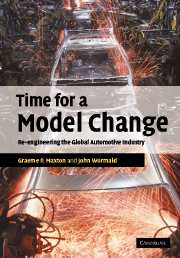Book contents
- Frontmatter
- Contents
- List of figures
- Foreword by G. Fredric Bolling
- Acknowledgements
- Glossary
- Introduction
- 1 From automania to maturity – in the main markets at least
- 2 The problems that can be fixed – dealing with noxious emissions, traffic accidents and congestion
- 3 The global resource challenges – energy and global warming
- 4 A global industry and the changing international order
- 5 The supplier industry – the catalyst for the profound changes to come?
- 6 The downstream sales and service sector
- 7 When the labels do not add up
- 8 Choosing a future for the automotive industry
- 9 Time for a model change
- Index
6 - The downstream sales and service sector
Published online by Cambridge University Press: 22 September 2009
- Frontmatter
- Contents
- List of figures
- Foreword by G. Fredric Bolling
- Acknowledgements
- Glossary
- Introduction
- 1 From automania to maturity – in the main markets at least
- 2 The problems that can be fixed – dealing with noxious emissions, traffic accidents and congestion
- 3 The global resource challenges – energy and global warming
- 4 A global industry and the changing international order
- 5 The supplier industry – the catalyst for the profound changes to come?
- 6 The downstream sales and service sector
- 7 When the labels do not add up
- 8 Choosing a future for the automotive industry
- 9 Time for a model change
- Index
Summary
A command economy – the franchised dealer sector
What happens after a car leaves the factory is the ‘downstream’ end of the business – it is the process of buying a car, having it serviced and reselling it. Although we tend to think of the purchase of the car itself as the biggest cost item, the downstream sector is a major part of the cost of motoring. It is also the profit engine of the industry. Figure 6.1 shows how significant the downstream sector is for the global automotive industry. It is where the money is made. Everything downstream excluding fuel, the government and the wider social arena, contributes over half of all profits. No wonder it is fought over so strenuously.
Figure 6.2 shows a breakdown of the cost of motoring in Europe, expressed as the lifecycle costs of a vehicle. The owner, or succession of owners, carry the depreciation of the vehicle, of which 70 to 75 per cent is its ex-factory cost and 25 to 30 per cent the costs of marketing and distributing it. Within the 25 to 30 per cent, 10 to 12 per cent is the discount or gross margin given to the dealer who retails the car. Excluding only the financing cost (the cost of the capital tied up in the vehicle during its life), insurance, and taxes and tolls, the downstream sector costs about 60 per cent of the whole.
- Type
- Chapter
- Information
- Time for a Model ChangeRe-engineering the Global Automotive Industry, pp. 164 - 210Publisher: Cambridge University PressPrint publication year: 2004



